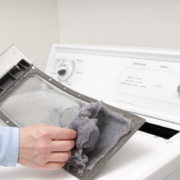Top Reasons Why Your Dryer Takes Too Long to Dry
It’s frustrating doing laundry when everything goes according to plan, but it’s even worse when you go to your dryer to pull your clothes out, reach in, and they’re still damp after an hour.
What’s going on?
There are some reasons you can troubleshoot to determine why your dryer is taking forever to do its job; we’ll go over some of those and discuss how to correct them. Keep in mind that if you don’t feel comfortable doing any troubleshooting on your own, Absolute Appliances Repair can help with your dryer repair. Here are some troubleshooting tips:
Incorrect Power Issues
Always start by checking the dryer’s power source. Electric dryers have to have a 240 volt outlet in order to receive enough power to operate properly (and dry thoroughly). Gas dryers can use a standard 120 volt outlet, but they do also require a proper gas line connection to receive enough power to perform. NEVER use an extension cord to power your dryer, regardless whether it’s electric or gas! They cannot safely provide the required voltage a dryer needs. If your machine is properly plugged into the appropriate voltage outlet, contact an appliance repair company in San Francisco to assess the gas connection for a gas dryer.
A Washing Machine Issue
Sometimes, a dryer isn’t able to properly dry clothing at no fault of its own. Is your washing machine properly spinning the load to extract enough water from your clothing? If you put clothing in the dryer that is literally dripping wet, your dryer is going to work really hard trying to dry it all, and won’t be able to do it in one cycle. Check to make sure the spin cycle on your washer is up to par.
Jammed Exhaust Vent
This is a pretty common cause of dryers not meeting our drying expectations! An expert in Marin County appliance repair could tell you horror stories about things that can clog dryer exhaust vents! These vents can get clogged with lint over time, even if you diligently clean the lint trap. Vent hoses can also become kinked or come loose from the wall, too. You’ll need to get behind your dryer and inspect the vent and straighten any kinks. It should be positioned at a 45 degree angle to ensure adequate airflow. Use a soft nylon brush or even a vacuum hose to remove lint from the area and to get rid of lint and debris where the venting attaches to the hood, too. Take the venting off and visually make sure nothing is blocking that air flow.
Way Too Much Clothing
Probably the most common cause of dryers not being able to dry in one cycle is overloading. If too much clothing is in there, hot air isn’t going to be able to properly circulate, making a cycle turn into a half day’s worth of work. Your manual should have instructions on the exact capacity of your specific model. You’d be surprised at how much having just a couple of extra pieces of clothing can make a difference with drying times!
Check Your Cycle Selection
Another common reason for dryer disappointment is that an incorrect cycle has been selected. It’s easy to forget that you changed the cycle for a previous load and forgot to change it back. Many machines today have an eco-friendly setting that uses less heat to dry, which can result in clothes that are still damp at the end of the cycle. If you never changed the dryer setting, check it anyway – you never know if someone else in the household might have.
If you’ve gone through troubleshooting your dryer and it still isn’t drying, you’ll likely need an appliance repair pro to come and take a look. Absolute Appliances Repair is certified to service all of the most popular makes and models of dryers, and we provide appliance repair for dryers, washers, dishwashers, ovens, stoves, freezers, refrigerators, and more. Contact us today – we serve residents of Marin County, Mill Valley, San Rafael, San Francisco, Larkspur, Novato, and the surrounding areas.






